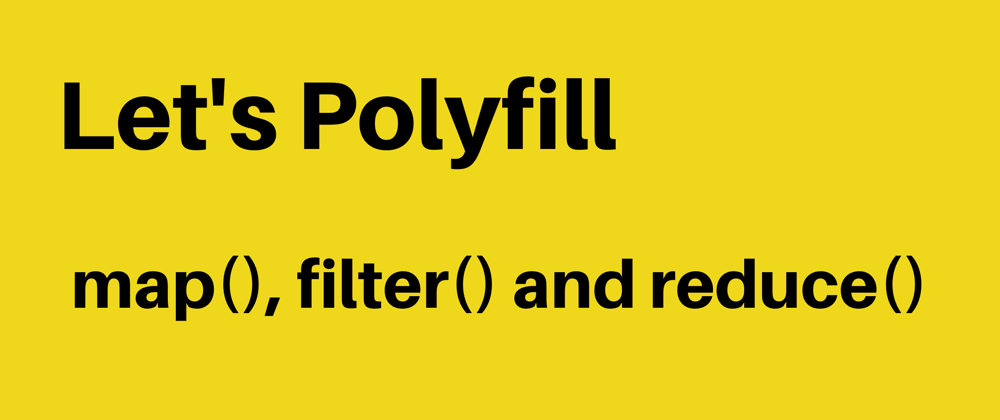Map
map is an Array method that takes in a callback and returns
an array of items that were returned from the callback
Example:
const arr = [1, 2, 3, 4];
const res = arr.map((el) => el * 2);
console.log(res); // returns [2,4,6,8]
Let's create our own map method called myMap
-
myMap()takes in a parameter which a callback/function. - It has a results array that gets returned by the
myMapfunction. - The returned values from our
cbare pushed in theresultsarray. - The
thishere would be the array that we will use thismyMapfunction on. - The traditional
map()callback can take 3 args. element, index and the source arr. We have done the same.
function myMap(cb) {
// rseults results array that gets returned at the end
const results = [];
for (let i = 0; i < this.length; i++) {
// returned values of our cb are pushed in the reults[]
// 'this' referes to the passed array
results.push(cb(this[i], i, this));
}
return results;
}
// Doing this will allow us to use arr.myMap() syntax
Array.prototype.myMap = myMap;
const arr = [1, 2, 3, 4, 5, 6];
const myMapResult = arr.myMap((el, _idx, _arr) => {
return el * 2;
});
console.log(myMapResult); //[2, 4, 6, 8, 10, 12];
Filter
filter() is an Array method that takes in a callback and returns
an array of items that satisfy the condition provided in our callback
Example:
const arr = [1, 2, 3, 4];
const res = arr.filter((el) => el % 2); // only return even numbers
console.log(res); // [2,4]
Let's create our own filter method called myFilter
-
myFilter()takes in a parameter which a callback/function. - It has a results array that gets returned at the end.
- The returned values from our
cbare pushed in theresultsarray. - The
thishere would be the array that we will use thismyFilterfunction on. - The traditional
filter()callback can take 3 args. element, index and the source arr. We have done the same.
function myFilter(cb) {
const results = [];
for (let i = 0; i < this.length; i++) {
const cbResult = cb(this[i], i, this);
// the returned value of callback is true only then push it to the results
if (cbResult) results.push(this[i]);
}
return results;
}
// Doing this will allow us to use arr.myFilter() syntax
Array.prototype.myFilter = myFilter;
const arr = [1, 2, 3, 4, 5, 6];
const foo = [
{ name: "S", age: 2 },
{ name: "V", age: 3 },
];
const myFilterResult = foo.myFilter((el, _idx, _arr) => {
return el.name !== "S";
});
console.log(myFilterResult); // [{ name: "V", age: 3 }]
Reduce
Here the MDN definition of it.
The reduce() method executes a reducer function (that you provide) on each element of the array, resulting in a single output value.
It takes in two important parameters.
accumulater and currentValue
Example:
const arr = [1, 2, 3, 4];
const res = arr.reduce((acc, curr) => {
acc += curr;
return acc;
}); // 10
console.log(res); // 10
Lets create our own reduce() method called myReduce()
-
myReduce()takes in a parameter which a callback/function. - It returns a single reduced value.
- The returned values from our
cbis assigned to theacc. - The
thishere would be the array that we will use thismyReducedfunction on. - The traditional
reduced()callback can take 4 args. accumulator, currentValue, index and the source arr. We have done the same.
function myReduce(cb, initialValue) {
let acc;
let curr;
if (!this.length && !initialValue)
throw new Error("Can't reduce on empty array, provide initial value");
else {
// If initialValue is given then acc is that or acc = is the 0th index of this
acc = initialValue ? initialValue : this[0];
for (let i = 1; i < this.length; i++) {
// current value of the array
curr = this[i];
// the retuned cb value is assigned to acc
acc = cb(acc, curr, i, this);
}
}
return acc;
}
// Doing this will allow us to use arr.myReduce() syntax
Array.prototype.myReduce = myReduce;
const myReduceResult = arr.myReduce((acc, curr, _idx, _arr) => {
acc += curr;
return acc;
});
console.log(myReduceResult); // 21
If you find any errors or edge cases in the above code then please let me know. I am happy to learn about them and add them here.
In the next blog in this series, I'll try and write our own debounce function from the loadash library
Also, if you guys want to see polyfills of your libs then let me know in the comments.
Hope this blog was helpful to you.







Top comments (0)